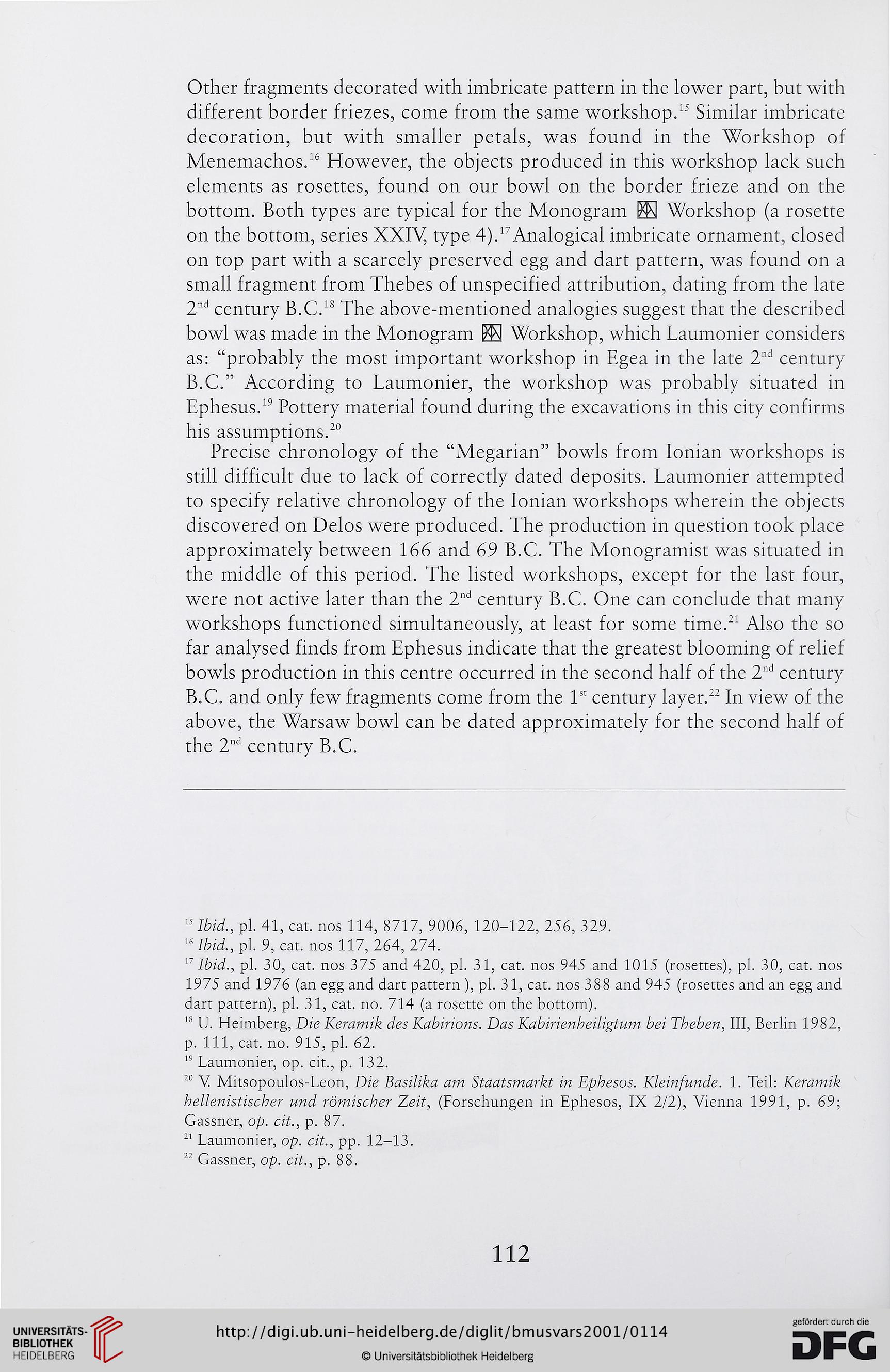Other fragments decorated with imbricate pattern in the lower part, but with
different border friezes, come from the same workshop.15 Similar imbricate
decoration, but with smaller petals, was found in the Workshop of
Menemachos.16 17 However, the objects produced in this workshop lack such
elements as rosettes, found on our bowl on the border frieze and on the
bottom. Both types are typical for the Monogram Workshop (a rosette
on the bottom, series XXIV, type 4).r Analogical imbricate ornament, closed
on top part with a scarcely preseryed egg and dart pattern, was found on a
smali fragment from Thebes of unspecified attribution, dating from the late
2nd century B.C.18 The above-mentioned analogies suggest that the described
bowl was madę in the Monogram ® Workshop, which Laumonier considers
as: “probably the most important workshop in Egea in the late 2nd century
B.C.” According to Laumonier, the workshop was probably situated in
Ephesus.19 Pottery materiał found during the excavations in this city confirms
his assumptions.20
Precise chronology of the “Megarian” bowls from Ionian workshops is
still difficult due to lack of correctly dated deposits. Laumonier attempted
to specify relative chronology of the Ionian workshops wherein the objects
discovered on Delos were produced. The production in ąuestion took place
approximately between 166 and 69 B.C. The Monogramist was situated in
the middle of this period. The listed workshops, except for the last four,
were not active later than the 2nd century B.C. One can conclude that many
workshops functioned simultaneously, at least for some time.21 Also the so
far analysed finds from Ephesus indicate that the greatest blooming of relief
bowls production in this centre occurred in the second half of the 2nd century
B.C. and only few fragments come from the lst century layer.22 In view of the
above, the Warsaw bowl can be dated approximately for the second half of
the 2nd century B.C.
15 Ibid., pl. 41, cat. nos 114, 8717, 9006, 120-122, 256, 329.
16 Ibid., pl. 9, cat. nos 117, 264, 274.
17 Ibid., pl. 30, cat. nos 375 and 420, pl. 31, cat. nos 945 and 1015 (rosettes), pl. 30, cat. nos
1975 and 1976 (an egg and dart pattern ), pl. 31, cat. nos 388 and 945 (rosettes and an egg and
dart pattern), pl. 31, cat. no. 714 (a rosette on the bottom).
18 U. Heimberg, Die Keramik des Kabirions. Das Kabirienheiligtum bei Theben, III, Berlin 1982,
p. 111, cat. no. 915, pl. 62.
19 Laumonier, op. cit., p. 132.
20 V Mitsopoulos-Leon, Die Basilika am Staatsmarkt in Ephesos. Kleinfunde. 1. Teil: Keramik
hellenistischer und rómischer Zeit, (Forschungen in Ephesos, IX 2/2), Vienna 1991, p. 69;
Gassner, op. cit., p. 87.
21 Laumonier, op. cit., pp. 12-13.
22 Gassner, op. cit., p. 88.
112
different border friezes, come from the same workshop.15 Similar imbricate
decoration, but with smaller petals, was found in the Workshop of
Menemachos.16 17 However, the objects produced in this workshop lack such
elements as rosettes, found on our bowl on the border frieze and on the
bottom. Both types are typical for the Monogram Workshop (a rosette
on the bottom, series XXIV, type 4).r Analogical imbricate ornament, closed
on top part with a scarcely preseryed egg and dart pattern, was found on a
smali fragment from Thebes of unspecified attribution, dating from the late
2nd century B.C.18 The above-mentioned analogies suggest that the described
bowl was madę in the Monogram ® Workshop, which Laumonier considers
as: “probably the most important workshop in Egea in the late 2nd century
B.C.” According to Laumonier, the workshop was probably situated in
Ephesus.19 Pottery materiał found during the excavations in this city confirms
his assumptions.20
Precise chronology of the “Megarian” bowls from Ionian workshops is
still difficult due to lack of correctly dated deposits. Laumonier attempted
to specify relative chronology of the Ionian workshops wherein the objects
discovered on Delos were produced. The production in ąuestion took place
approximately between 166 and 69 B.C. The Monogramist was situated in
the middle of this period. The listed workshops, except for the last four,
were not active later than the 2nd century B.C. One can conclude that many
workshops functioned simultaneously, at least for some time.21 Also the so
far analysed finds from Ephesus indicate that the greatest blooming of relief
bowls production in this centre occurred in the second half of the 2nd century
B.C. and only few fragments come from the lst century layer.22 In view of the
above, the Warsaw bowl can be dated approximately for the second half of
the 2nd century B.C.
15 Ibid., pl. 41, cat. nos 114, 8717, 9006, 120-122, 256, 329.
16 Ibid., pl. 9, cat. nos 117, 264, 274.
17 Ibid., pl. 30, cat. nos 375 and 420, pl. 31, cat. nos 945 and 1015 (rosettes), pl. 30, cat. nos
1975 and 1976 (an egg and dart pattern ), pl. 31, cat. nos 388 and 945 (rosettes and an egg and
dart pattern), pl. 31, cat. no. 714 (a rosette on the bottom).
18 U. Heimberg, Die Keramik des Kabirions. Das Kabirienheiligtum bei Theben, III, Berlin 1982,
p. 111, cat. no. 915, pl. 62.
19 Laumonier, op. cit., p. 132.
20 V Mitsopoulos-Leon, Die Basilika am Staatsmarkt in Ephesos. Kleinfunde. 1. Teil: Keramik
hellenistischer und rómischer Zeit, (Forschungen in Ephesos, IX 2/2), Vienna 1991, p. 69;
Gassner, op. cit., p. 87.
21 Laumonier, op. cit., pp. 12-13.
22 Gassner, op. cit., p. 88.
112




